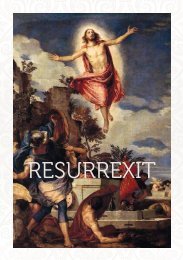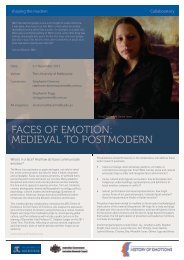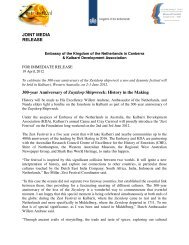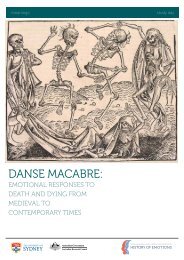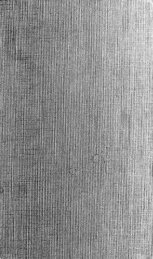Download our K-12 education pack - ARC Centre of Excellence for ...
Download our K-12 education pack - ARC Centre of Excellence for ...
Download our K-12 education pack - ARC Centre of Excellence for ...
Create successful ePaper yourself
Turn your PDF publications into a flip-book with our unique Google optimized e-Paper software.
stories <strong>for</strong> teachers & students 2013<br />
Supporting Res<strong>our</strong>ces<br />
South Africa, Far from Home<br />
stories by winthrop pr<strong>of</strong>essor susan broomhall<br />
Sharing the Islamic faith at the Cape:<br />
Resistance and its consequences<br />
in the VOC Indian Ocean network<br />
The Cape Colony was set up as a supply station to the ships<br />
passing the Cape en route <strong>for</strong> Batavia. However, it soon became<br />
something more politically and socially embedded in the VOC<br />
Indian Ocean network.<br />
From 1654, the Cape began to be used as a place <strong>of</strong> punishment<br />
<strong>for</strong> those from other parts <strong>of</strong> the VOC communities. When f<strong>our</strong><br />
men preached against VOC rule <strong>of</strong> Batavia, they had been<br />
sentenced by the High C<strong>our</strong>t <strong>of</strong> Justice there to banishment and<br />
hard lab<strong>our</strong> <strong>for</strong> life: three went to Mauritius and one to the Cape<br />
colony. This policy was to have particular significance <strong>for</strong> the<br />
population that created the present South Africa. In particular, it<br />
brought a large number <strong>of</strong> Muslims from south-east Asia –<br />
especially what is now Indonesia and Malacca. Some were<br />
slaves, others were free Muslims (known as Mardyckers), and a<br />
significant group were Muslim political leaders who sought to<br />
get rid <strong>of</strong> the Europeans from they saw as their homelands. In<br />
doing so, the VOC governors brought the Islamic faith to South<br />
Africa, one that has enriched the culture <strong>of</strong> the nation today.<br />
Many Muslims in South Africa today call themselves ‘Cape<br />
Malay’ although not all <strong>of</strong> them came from the Malay area.<br />
The Muslim political leaders, called Orang Cayen, were angry<br />
and vocal, many were rich, well educated, and influential, and<br />
from the VOC’s point <strong>of</strong> view, dangerous to keep in Batavia where<br />
they could stir up more trouble. The VOC solution was to send<br />
these political dissidents away as far as they could, and the Cape<br />
colony seemed the perfect place. Two <strong>of</strong> the first to arrive in 1667<br />
were the rulers <strong>of</strong> Sumatra, Sheikh Abdurahman Matahe Sha<br />
and Sheikh Mahmood. After 1681, the Cape was the designated<br />
place to exile important resistance fighters against the VOC,<br />
where it was imagined they could do least damage to the<br />
Company. In that year, Maccassarian princes arrived at the Cape.<br />
Perhaps one <strong>of</strong> the most famous exiles was Shaykh Yusuf, ‘Abidin<br />
Tadia Tjoessoep, born in Goa in India but a Chief Religious Judge<br />
and personal advisor <strong>of</strong> Sultan Ageng <strong>of</strong> Banten. He arrived in<br />
the Cape in 1694 with a retinue <strong>of</strong> 49 family members, slaves and<br />
followers. He had already escaped twice from VOC <strong>of</strong>ficials. So<br />
important was he that the VOC governor at the Cape, Simon van<br />
der Stel, came to welcome him ashore. He was given a house at<br />
Zandvliet which kept him at a distance from the Cape. This did<br />
not isolate him as the company hoped, but rather made Zandvliet<br />
a place <strong>of</strong> hope and support <strong>for</strong> fugitives and exiles. This was to<br />
become the first organised Muslim community in South Africa. In<br />
1994, Muslims in South Africa commemorated 300 years <strong>of</strong> Islam<br />
from the arrival <strong>of</strong> Sheikh Yusuf.<br />
The presence <strong>of</strong> educated Muslim leaders was to have a<br />
pr<strong>of</strong>ound impact on the development <strong>of</strong> South African identity.<br />
For example, Cape Town Muslims were the first to write<br />
Afrikaans, in the Arabic script, from the 1830s, be<strong>for</strong>e the<br />
language was <strong>of</strong>ficially recognised. The community grew larger<br />
with converts, as a Muslim identity became attractive to non-<br />
Europeans in the colony who sought social advancement, a<br />
community that provided <strong>education</strong>, medical services and<br />
financial support, and a spirituality that was not as exclusive as<br />
Christianity. Muslim clerics, <strong>for</strong> example, were willing to baptise<br />
Image/ Pamphlet in Arabic Afrikaans urging people to vote.<br />
From the private collection <strong>of</strong> Dr. S. Jeppie<br />
a child born to parents <strong>of</strong> different ethnic origins (mixed<br />
ancestry), where Christian clergy were not.<br />
But the Christian governors <strong>of</strong> the VOC were not happy to see<br />
Islam freely practised. The Mardyckers, <strong>for</strong> example, had arrived<br />
at the Cape from Amboyna in Indonesia, as part <strong>of</strong> the work<strong>for</strong>ce<br />
that Jan van Riebeeck had requested <strong>for</strong> the new colony. But they<br />
were told not to practise their religion in public. The Statute <strong>of</strong><br />
India, drafted by Antonie van Diemen in 1642, which also<br />
governed the Cape colony, ordered that they could ‘not practise<br />
in public or venture to propagate it amongst Christians and<br />
heathens’. There is some evidence that these regulations were<br />
not strictly en<strong>for</strong>ced as visitors to the Cape in the eighteenth<br />
century were able to document Islamic religious services.<br />
However, it was not until 1804 that full religious freedom was<br />
<strong>of</strong>ficially permitted at the Cape.<br />
The first mosque at the Cape, Auwal Mosque, was built on land<br />
donated by a Muslim woman, Saartjie van de Kaap, who was<br />
born to slave parents and was the wife <strong>of</strong> Imam Achmat. She was<br />
the first female Malay land-owner in Cape Town and gave the<br />
land to the Muslim community as a gift in 1811. Be<strong>for</strong>e this time,<br />
prayer rooms had been created in the homes <strong>of</strong> Imams.<br />
The continued and growing Muslim faith community in South<br />
Africa reflected a determination to resist VOC power to control<br />
lives and fates, even where people were moved by the Company’s<br />
orders far across oceans as slaves, exiles, or free lab<strong>our</strong>ers.<br />
Islam provided a focus <strong>for</strong> a shared non-European identity in the<br />
Cape colony, one which could (and still does) provide both<br />
important spiritual and social meaning <strong>for</strong> its members.<br />
FAR FROM HOME: ADVENTURES, TREKS, EXILES & MIGRATION<br />
43





